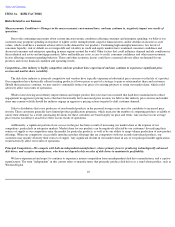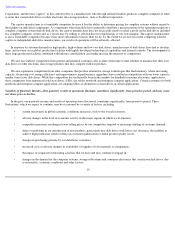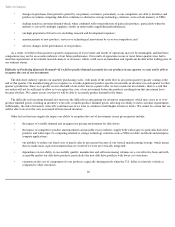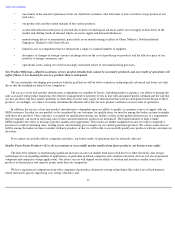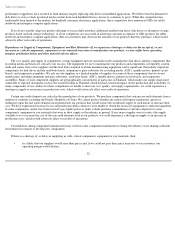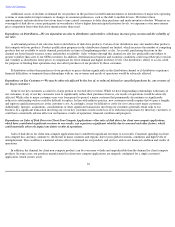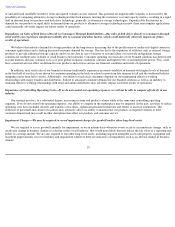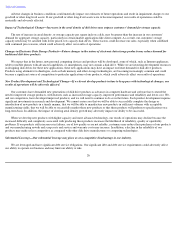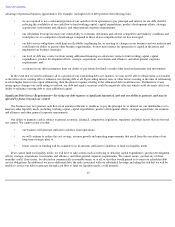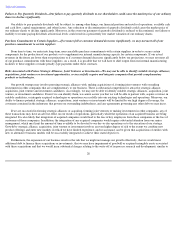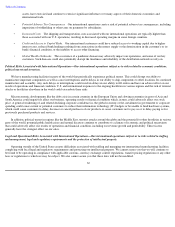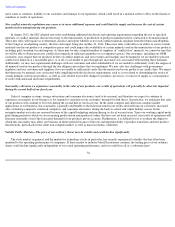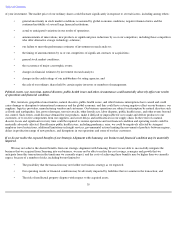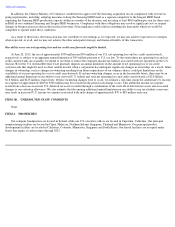Seagate 2012 Annual Report Download - page 30
Download and view the complete annual report
Please find page 30 of the 2012 Seagate annual report below. You can navigate through the pages in the report by either clicking on the pages listed below, or by using the keyword search tool below to find specific information within the annual report.
Table of Contents
advantage of potential business opportunities. For example, our high level of debt presents the following risks:
• we are required to use a substantial portion of our cash flow from operations to pay principal and interest on our debt, thereby
reducing the availability of our cash flow to fund working capital, capital expenditures, product development efforts, strategic
acquisitions, investments and alliances, and other general corporate requirements;
• our substantial leverage increases our vulnerability to economic downturns and adverse competitive and industry conditions and
could place us at a competitive disadvantage compared to those of our competitors that are less leveraged;
•
our debt service obligations could limit our flexibility in planning for, or reacting to, changes in our business and our industry and
could limit our ability to pursue other business opportunities, borrow more money for operations or capital in the future and
implement our business strategies;
• our level of debt may restrict us from raising additional financing on satisfactory terms to fund working capital, capital
expenditures, product development efforts, strategic acquisitions, investments and alliances, and other general corporate
requirements; and
• covenants in our debt instruments limit our ability to pay future dividends or make other restricted payments and investments.
In the event that we need to refinance all or a portion of our outstanding debt as it matures, we may not be able to obtain terms as favorable
as the terms of our existing debt or refinance our existing debt at all. If prevailing interest rates or other factors existing at the time of refinancing
result in higher interest rates upon refinancing, then the interest expense relating to the refinanced debt would increase. Furthermore, if any
rating agency changes our credit rating or outlook, our debt and equity securities could be negatively affected, which could adversely affect our
ability to refinance existing debt or raise additional capital.
Significant Debt Service Requirements
—Servicing our debt requires a significant amount of cash and our ability to generate cash may be
affected by factors beyond our control.
Our business may not generate cash flow in an amount sufficient to enable us to pay the principal of, or interest on, our indebtedness or to
fund our other liquidity needs, including working capital, capital expenditures, product development efforts, strategic acquisitions, investments
and alliances and other general corporate requirements.
Our ability to generate cash is subject to general economic, financial, competitive, legislative, regulatory and other factors that are beyond
our control. We cannot assure you that:
• our business will generate sufficient cash flow from operations;
• we will continue to realize the cost savings, revenue growth and operating improvements that result from the execution of our
long-term strategic plan; or
• future sources of funding will be available to us in amounts sufficient to enable us to fund our liquidity needs.
If we cannot fund our liquidity needs, we will have to take actions such as reducing or delaying capital expenditures; product development
efforts, strategic acquisitions, investments and alliances, and other general corporate requirements. We cannot assure you that any of these
remedies could, if necessary, be effected on commercially reasonable terms, or at all, or that they would permit us to meet our scheduled debt
service obligations. In addition if we incur additional debt, the risks associated with our substantial leverage, including the risk that we will be
unable to service our debt or generate enough cash flow to fund our liquidity needs, could intensify.
27



